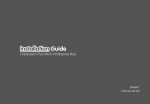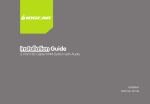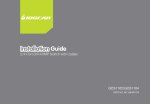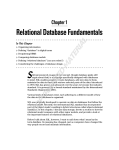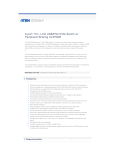Download iogear GCS1924 KVM switch
Transcript
User Manual 4-Port DualView Mini DisplayPort KVMP Switch with Peripheral Sharing 1 GCS1924 PART NO. M1203 ©2012 IOGEAR®. All Rights Reserved. PKG-M1203 IOGEAR, the IOGEAR logo, MiniView®, VSE are trademarks or registered trademarks of IOGEAR. Microsoft and Windows are registered trademarks of Microsoft Corporation. IBM is a registered trademark of International Business Machines, Inc. Macintosh, G3/G4 and iMac are registered trademarks of Apple Computer, Inc. IOGEAR makes no warranty of any kind with regards to the information presented in this document. All information furnished here is for informational purposes only and is subject to change without notice. IOGEAR assumes no responsibility for any inaccuracies or errors that may appear in this document. 2 Table of Contents Package Content 4 Mac Keyboard Emulation 24 System Requirements 5 Factory Default Hotkeys Settings 25 GCS1924 Overview 6 Firmware Upgrade 26 Installation9 Upgrade Fail 31 LED Indication 14 Federal Communications Commission (FCC) Port Switching 15 Statement32 Port Switching via Hotkeys 17 CE Compliance 33 Auto Scanning 19 SJ/T 11364-2006 34 Hotkey Setting Mode (HSM) 20 Limited Warranty 35 Digital & Analog Audio Setup Table 23 Contact36 3 Package Content –– –– –– –– –– –– –– –– 1 x 4-port DualView Mini DisplayPort KVMP Switch 8 x Mini DisplayPort 1.1a Cable 4 x USB 2.0 Cable (Type A to Type B) 4 x 3.5mm Audio Cable (Green Head) 4 x 3.5mm Mic Cable (Pink Head) 1 x User Manuel 1 x Power Adapter 1 x Warranty Card 4 System Requirements Console –– Two mini DisplayPort Monitors –– 1 x USB Keyboard –– 1 x USB Mouse –– Speaker / Microphone (Analog / Digital) – Optional * * Front Audio Port supports Analog Audio output only Computer –– mini DisplayPort (Single / Dual mini DisplayPort Video card) –– Type “A” USB Port Operating System –– Window XP / VISTA / 7 –– MAC OSX 10.5.4 or greater 5 GCS1924 Overview Front View 1. Port 1 Touch Panel 2. Port 2 Touch Panel 3. Mode Touch Panel 4. Port 3 Touch Panel 5. 6. 7. 8. 1 Port 4 Touch Panel Front Panel Console Mic. Connection (analog only) Front Panel Console Audio Connection (analog only) Front Panel USB 2.0 Peripheral Sharing Port (w/ Quick Charge) 2 3 6 4 5 6 7 8 Rear View 1. CPU 2 Mini DisplayPort 2B 2. CPU 2 Mini DisplayPort 2A 3. CPU 2 Mini-TOSLINK Mic. (Digital/Analog) 4. CPU 2 Mini-TOSLINK Audio (Digital/Analog) 5. CPU 2 USB Connection 6. CPU 1 Mini DisplayPort 1B 1 3 2 5 7. CPU 1 Mini DisplayPort 1A 8. CPU 1 Mini-TOSLINK Mic. (Digital/Analog) 9. CPU 1 Mini-TOSLINK Audio (Digital/Analog) 10.CPU 1 USB 2.0 Connection 11.Console USB 2.0 Peripheral Sharing Port 4 12.Console Mini DisplayPort B 13.Console Mini DisplayPort A 14.Console Mini-TOSLINK Mic. (Digital/Analog) 15.Console Mini-TOSLINK Audio (Digital/Analog) 16.Console USB Mouse Port 17.Console USB Keyboard Port 18.DC Power Jack 6 8 9 12 14 7 10 7 11 13 16 17 15 18 Side View 6. CPU 3 Mini DisplayPort 3B 7. CPU 3 Mini DisplayPort 3A 8. CPU 3 Mini-TOSLINK Mic. Connection (Digital/Analog) 9. CPU 3 Mini-TOSLINK Audio Connection (Digital/Analog) 10.CPU 3 USB 2.0 Connection 1. CPU 4 Mini DisplayPort 4B 2. CPU 4 Mini DisplayPort 4A 3. CPU 4 Mini-TOSLINK Mic. Connection (Digital/Analog) 4. CPU 4 Mini-TOSLINK Audio Connection (Digital/Analog) 5. CPU 4 USB Connection 3 4 1 5 2 8 8 9 6 10 7 Installation STEP 1 Please make sure your source devices and displays are powered off before you start. STEP 2 Connect the mini DisplayPort cables from your monitors to the console mini DisplayPort A and/or B. Port A will be your main monitor and Port B will be your extended desktop monitor. B 9 A STEP 3 Connect your USB keyboard and mouse to the console USB keyboard port and console USB mouse port. Connect your USB devices to the USB peripheral port, you can add a USB hub if you need to connect multiple USB devices. 10 STEP 4 Connect your mini DisplayPort and a set of IOGEAR custom cable (USB 2.0 and Audio Jack 3.5mm) from KVMP switch to each of your computers – mini DisplayPort connection from mini DisplayPort A to the mini DisplayPort output and USB connection to open USB port from your computer. Connect the audio and mic. connectors to your audio output and mic. input A 11 STEP 5 Connect mini DisplayPort cables from mini DisplayPort B of the KVMP to your second mini DisplayPort output of your computers. Repeat the same for port #2, 3 and 4. A B 12 STEP 6 Plug the power adapter into the power outlet and connect it to the DC power jack from the KVMP Final Step Installation is complete. Turn on your computers and other devices and enjoy. 13 LED Indication LED Online / Selected Description Dim Orange A device is connected to the KVMP switch but the port is not on focus Bright Orange The specific port has focus on the KVM (Keyboard, video and mouse) Audio Green The specific port has focus on the audio USB Link Green The specific port has focus on the USB peripheral sharing ports 14 Port Switching Simply touch the front panel from the multimedia KVMP switch or trigger hotkeys from your keyboard. Port Switching via Front Panel Touch Function Touch Panel Control Switch all focus (KVM, audio and USB) to a specific port 1.Touch MODE once, KVM , AUDIO , and USB LINK LEDs will flash 2.Then touch the specific port to switch all focus to that port Switch KVM focus to a specific port 1.Touch MODE twice, KVM LED will flash 2.Then touch the specific port to switch KVM port to that port 15 Switch audio focus to a specific port 1.Touch MODE three times, AUDIO LEDs will flash 2.Then, touch the specific port to switch Audio port to that port Switch USB focus to a specific port 1.Touch MODE four times, USB LINK LED will flash 2.Then, touch the specific port to switch USB focus to that port 16 Port Switching via Hotkeys Port Switching via Hotkeys Hotkeys Description [Scroll Lock] [Scroll Lock] [Enter] Switch all focus (KVM, audio and USB) to the next port [Scroll Lock] [Scroll Lock] [n] [Enter] Switch all focus (KVM, audio and USB) to port n* [Scroll Lock] [Scroll Lock] [k] [Enter] Switch KVM focus to the next port [Scroll Lock] [Scroll Lock] [n] [k] [Enter] Switch KVM focus to port n* [Scroll Lock] [Scroll Lock] [s] [Enter] Switch audio focus to the next port [Scroll Lock] [Scroll Lock] [n] [s] [Enter] Switch audio focus to port n* [Scroll Lock] [Scroll Lock] [u] [Enter] Switch USB focus to the next port [Scroll Lock] [Scroll Lock] [n] [u] [Enter] Switch USB focus to port n* Continue next page 17 Port Switching via Hotkeys [Scroll Lock] [Scroll Lock] [n] [k] [u] [Enter] Switch KVM and USB focus to port n* [Scroll Lock] [Scroll Lock] [n] [k] [s] [Enter] Switch KVM and audio focus to port n* [Scroll Lock] [Scroll Lock] [n] [u] [s] [Enter] Switch USB and audio focus to port n* *Note: n is an interval that stands for the Port number k stands for KVM focus s stands for audio focus u stands for USB focus 18 Auto Scanning You can either activate Autoscan Mode via front panel push button or hotkeys. Function Description Front panel pushbutton Auto Scan Hotkeys Press and hold port 1 and port 2 Pushbutton simultaneously for 2 seconds to activate Autoscan Mode* [Scroll Lock] [Scroll Lock] [a] [Enter] Activate Autoscan mode. It will cycle from port to port every 5 seconds (default) [Scroll Lock] [Scroll Lock] [a] [n] [Enter] Activate Autoscan mode. It will cycle from port to port every n seconds** *Note: Autoscan Mode from front panel push button will be scanning a port every 5 seconds by default. If you wish to have the Autoscan Mode be scanning with different time interval, please refer to trigger Autoscan Mode from hotkeys. **Note: n is an interval between 1 and 99 that stands for the time (in second) desired for scanning each port. 19 Hotkey Setting Mode (HSM) Hotkey Description 1. Press and hold [Num Lock] (Use the [Clear] key on a Mac keyboard.) 2. Press and release [-] 3. Release [Num Lock] (Use the [Clear] key on a Mac keyboard.) Invoking hotkey setting mode Invoke HSM, then press [h] Change the HSM invocation keys from [Num Lock] to [Ctrl] and from [-] to [F12] Invoke HSM, then press [t] Switch port switching hotkey sequence between [Scroll Lock] [Scroll Lock] and [Ctrl] [Ctrl] Invoke HSM, then press [F2] Enables Mac keyboard emulation Invoke HSM, then press [F3] Enables Sun keyboard emulation Invoke HSM, then press [F10] Auto-detect the keyboard operating platform (for PC compatible systems). Activates Pass Through Keyboard Mode (keystrokes are sent directly to the computer instead of through the Mac emulator). 20 Hotkey Description Invoke HSM, then press [l] Quick charge mode Invoke HSM, then press [e] power on detection Invoke HSM, then press [n] + [enter] enables game mode Invoke HSM, then press [w] mouse port switch Invoke HSM, then press [F4] List hotkey settings – simply invoke the hotkey and then open a text editor, such as notepad, and use the Paste function to display the hotkey settings. Invoke HSM, then press [F5] USB Reset Invoke HSM, then press [b] Toggle hotkey beepers on or off Invoke HSM, then press [x] [Enter] Disable or enable port switching hotkey Invoke HSM, then press [u] [p] [g] [r] [a] [d] [e] [Enter] Activate Firmware Upgrade Mode – Front panel KVM LED will flash indicating Firmware Upgrade Mode is activated. 21 Hotkey Description Invoke HSM, then press [r] [Enter] Restore default settings Invoke HSM, then press [d] Capture and store video information on specific port Invoke HSM, then press [m] Enable or disable mouse emulation Invoke HSM, then press [F1] Reset keyboard and mouse under some special OS’ that do not support USB 2.0 *Note: To exit HSM manually, press Esc or spacebar 22 Digital & Analog Audio Setup Table GCS1924 offers both digital and analog Audio; the rule of the audio distribution is “digital in digital out” and “analog in analog out”. The table below explains this in detail. KVM Console Audio Out "Digital Audio Out (Refer to #15 on Page 7)" "Analog Audio Out (Refer to #15 on Page 7 and #7 on Page 6)" Digital In Digital Out No Audio Analog In No Audio Analog Out Digital In Digital Out No Audio Analog In No Audio Analog Out Digital In Digital Out No Audio Analog In No Audio Analog Out Digital In Digital Out No Audio Analog In No Audio Analog Out KVM CPU Audio CPU 1 CPU 2 CPU 3 CPU 4 *For Front Panel Audio/Mic, it only outputs Analog signal through sound stereo devices. **When both Console Audio and Front Panel Audio are connected, “Only” Front Panel Audio will output Audio signal. 23 Mac Keyboard Emulation The PC compatible (101/104 key) keyboard can emulate the functions of the Mac keyboard. The emulation mappings are listed in the table below. PC Keyboard Mac Keyboard PC Keyboard Mac Keyboard [Shift] Shift [Print Screen] F13 [Crtl] Ctrl [Scroll Lock] F14 = [Ctrl] [1] [Enter] Return [Ctrl] [2] [Backspace] Delete [Ctrl] [3] [Insert] Help [Ctrl] [4] [Ctrl] F15 [Alt] Alt *Note: When using key combinations, press and release the first key (Ctrl), then press and release the second key. 24 Factory Default Hotkeys Settings Function Default Port Switching [Scroll Lock] [Scroll Lock] Invoking HSM [Num Lock] [-] Auto Scan Interval 5 Seconds Beeper On Keyboard Operating Platform PC Compatible Port Switching Keys Enabled Mouse Emulation On 25 Firmware Upgrade Note: In order to perform a firmware upgrade, you need to use a computer that’s not connected to the KVM. Step 1 Connect the provided firmware upgrade cable to the firmware upgrade port of the KVM and the serial port of your computer. Connect power adapter to your power outlet and the KVM. Step 2 Go to www.iogear.com to download the latest available firmware or the specific firmware that you wish to upgrade to. Step 3 Shut down all the computers that are connected to the KVM. Then Invoke Firmware Upgrade Mode. (Please refer to Hotkeys Setting Mode section.) Step 4 Extract the file with WinRAR or compatible software. Then double click on the execute file to begin with the Firmware Upgrade Utility. 26 Step 5 Read the License Agreement and click “I Agree” then click “Next” if you wish to continue with the firmware upgrade. Otherwise, click “Cancel” to exit. 27 Step 6 Choose the correct KVM that you wish to perform firmware upgrade from the “Device List” and then click “Next” to continue. Then the Firmware Upgrade Utility will verify if there is a KVM connected to the computer by the firmware upgrade cable. (Check Firmware Version checkbox is optional) 28 Step 7 If you have checked the “Check Firmware Version” checkbox, then the utility will check the current firmware that is on your KVM. If the current firmware is newer than the firmware that you wish to upgrade to, a window will popup and prompt you to ask if you wish to proceed. Simply click “Yes” to start the upgrade and “No” to cancel the upgrade. Note: If you did not check the “Check Firmware Version” checkbox, utility will perform the upgrade automatically no matter what version of firmware you have in the KVM. 29 Step 8 When the firmware upgrade is done, you will see “Firmware upgrade OK” in the “Status Messages” window. Then simply click “Finish” to complete the whole firmware upgrade process. Final Step Now the KVM will reset by itself and it will be ready for usage after the rest. Note: If you see warring message of Mac O.S. version incompatible, please contact IOGEAR service staff for latest firmware upgrade tool 30 Upgrade Fail If you don’t see “Firmware upgrade OK” in the “Status Messages” window, it means the utility has failed to complete the firmware successfully. If that occurs, please do the following: Step 1 Unplug all USB cables and DC power adapter from GCS1924. Step 2 Plug single USB cable in the last CPU port with PC powered on. Step 3 Plug DC power adapter, the GCS1924's port LED will start flash after powered on. Step 4 Run FW upgrade program again 31 Federal Communications Commission (FCC) Statement This equipment has been tested and found to comply with the limits for a Class B digital device, pursuant to Part 15 of the FCC Rules. These limits are designed to provide reasonable protection against harmful interference in a residential setting. This product generates, uses, and can radiate radio frequency energy and, if not installed and used as directed, it may cause harmful interference to radio communications. Although this product complies with the limits for a Class B digital device, there is no guarantee that interference will not occur in a particular installation. 32 CE Compliance This device has been tested and found to comply with the following European Union directives: Electromagnetic Capability (89/336/EMC), Low Voltage (73/23/EEC) and R&TTED (1999/5/EC). 33 SJ/T 11364-2006 The following contains information that relates to China. 有毒有害物质或元素 部件名称 铅 (Pb) 汞 (Hg) 镉(Cd) 多溴联苯 多溴二苯醚 (PBB) (PBDE) 六价 (Cr(VI)) 电器部件 ● ○ ○ ○ ○ ○ 机构部件 ○ ○ ○ ○ ○ ○ ○:表示该有毒有害物质在该部件所有均质材料中的含量均在SJ/T 11363-2006规定的限量要求之下。 ●:表示符合欧盟的豁免条款,但该有毒有害物质至少在该部件的某一均质材料中的含量超出 SJ/T 11363-2006的限量要求。 ×:表示该有毒有害物质至少在该部件的某一均质材料中的含量超出SJ/T 11363-2006的限量要求。 34 Limited Warranty WE’RE HERE TO HELP YOU! NEED ASSISTANCE SETTING UP THIS PRODUCT? Make sure you: 1. Visit www.iogear.com for more product information 2. Visit www.iogear.com/support for live help and product support Warranty Information This product carries a 3 Year Limited Warranty. For the terms and conditions of this warranty, please go to http://www.iogear.com/support/warranty Register online at http://www.iogear.com/register Important Product Information Product Model Serial Number 35 Contact IOGEAR Toll Free 866-9-IOGEAR (USA) Phone: 949-453-8782 19641 Da Vinci, Foothill Ranch, CA92610 www.iogear.com [email protected] 36 37 About Us FUN IOGEAR offers connectivity solutions that are innovative, fun, and stylish, helping people enjoy daily life using our high technology products. GREEN IOGEAR is an environmentally conscious company that emphasizes the importance of conserving natural resources. The use of our technology solutions helps reduce electronic waste. 38 © 2012 IOGEAR®






































